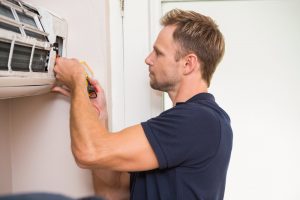Central Air Conditioning: Cooling Your Home
Central air conditioners use a system of supply as well as return ducts to circulate cool air. Openings in walls, ceilings, or floors are covered by grilles and connected to supply ducts and registers. As the cooled air circulates in your home, it will get warmer, and then it is made to go back to the central air conditioner through registers and return air ducts.
Any incoming air that passes through an air conditioner gets dehumidified, but if you live in climates that are very humid, or where your air conditioner is of a size bigger than what is needed, then the humidity level achieved may not be low. You can run a dehumidifier in addition, but that will increase your use of energy, as both these equipment, the dehumidifier and the air conditioner will require more energy for cooling your home. An alternative that is preferred is the installation of a dehumidifying heat pipe, which you can retrofit even into an existing system.
Central Air Conditioner Types
A central air conditioner can be a packaged unit or one that has a split system.
Split-system air conditioners fitted for central cooling have a metal cabinet placed outdoors that houses the compressor and condenser, while a cabinet that is indoors contains the evaporator. You will find that in many split type central air conditioners this indoor unit may also have the indoor part of a heat pump or a furnace. If your home is already equipped with a furnace, the most economical air conditioner to install will be the split-system type.
Packaged central air conditioners on the other hand, will have the evaporator, the condenser, as well as the compressor all fixed in the same cabinet, which is usually located on a roof, or next to the foundation of the house on a concrete slab. Small commercial buildings opt for this type of air conditioner. This packaged air conditioner is usually located outside the house and the ducts, both supply and return, run outside from inside through a opening in the exterior wall of the home. These packaged air conditioners can also include heating coils or a furnace that runs on natural gas. The combination of a heater and air conditioner makes it unnecessary to install a separate furnace inside the home.
Choose or Upgrade Your Central Air Conditioner
The efficiency of central air conditioners is much higher than that of window air conditioners. To add to that, their being installed out of the way, makes them quiet and convenient for operation. You can save both energy and money, if you buy a central air conditioner that is energy-efficient and also limit its energy use. Air conditioning your average sized home will result in the electricity consumption of 2000 kilowatt hours every ear, and which results in power plants emitting 3500 pounds of CO2, as well as 31 pounds of SO2.
The deciding factor in opting for a central air conditioner is the need to install ducts in your home.
The compressor of older central air conditioners are best replaced with modern units that have a high efficiency. If you are doing so, take the advice of a local contractor who does work for heating and cooling, and ask him to determine whether the compressor that you are contemplating buying, matches with the indoor unit. Recently many changes have been made in air conditioning systems and refrigerants, it may be more advisable to replace the complete system rather than the expense of air conditioner repair.

Modern day air conditioners produce the same amount of cooling as those made in the 1970s, but use 30% to 50% lesser energy.
Even if your air conditioner is just 10 years old, the savings in energy can still be 20% to 40%, if you do the replacement with a model that is newer and more efficient.
The efficiency of a central air conditioner also can be dependent on its proper sizing and installation. A larger unit will not be able to remove all the humidity. A smaller unit will not give you a comfortable temperature on days that are very hot. Efficiency gets greatly reduced if the installation of ducts is not proper, the unit is incorrectly located, or there is a lack of insulation.
Look for high efficiency models when you are buying that central air conditioner.
SEER, or seasonal energy efficiency is the rating given to central air conditioners. It indicates, the relative quantum of energy for providing a specific cooling output. Older systems have a rating of less than 10.
Look at buying an energy efficient model to replace your old air conditioner. Units that are qualified with an ENERGY STAR or Energy guide label have a 15% higher efficiency than standard models. On January 1, 2015, new standards came into effect for residential central air conditioners. You need to look in detail at these efficiency standards, and will have greater savings if you purchase a system with Higher SEER ratings.
These standards do not require you to change any system that you have already installed earlier, and you should still be able to avail of services and the needed replacement parts for it. Most central air conditioners have a life span that is between 15 and 20 years. Even after the new standards have become effective, manufacturers of your older equipment will still continue to support it by honouring any maintenance contract and making parts available for this.
Buying an air conditioner will require you to have a look at other features as well, and this includes:
- A high efficiency operation when the summer heat is at its peak, needs a thermal expansion valve that has a high temperature rating (EER) that should be more than 11.6
- A new ventilation system needs a variable speed air handler
- A unit needs to operate quietly
- A fan only switch that can be used for ventilation at night so that air conditioning costs can be reduced
- A check light for your filter that reminds that your filter needs to be checked after your unit has worked for a predetermined number of hours
- A fan switch with automatic delay, that switches off the fan a few minutes after the compressor is turned off
Locating and Installing Air Conditioners
A correctly installed air conditioner, or one that has had its installation problems fixed after it has been found faulty, is an air conditioner that will only require minor maintenance while it performs efficiently for years. The fact, however, is that many air conditioners are not correctly installed. The result is that even the modern energy efficient models can perform as poorly as the older models that were considered inefficient.
To make sure of correct installation, make sure that the air conditioning contractor:
- Allows use of an indoor space that is adequate for installation and carrying out maintenance and repair. He must also provide the furnace or duct with an access door that allows the evaporator coil to be easily cleaned
- Uses technology for duct sizing that is an approved one
- Makes sure that the number of registers for the delivering cool air and return air registers for carrying warm air back to the air conditioner are adequate
- That, wherever possible, the ducts are in the space that is being conditioned, and not in the attic
- Heavily insulates all ducts and also seals them with duct mastic
- If possible, locates the condensing units in a place that will not disturb you or your neighbors at night
- Locates the condensing unit so that air flowing to it is not obstructed by any objects
- Verifies that the new installation for the air conditioner has a charge of refrigerant and air flow rate that the manufacturer has specified
- Ensures that the thermostat is not near to any window, supply registers, or any other heat sources
If your old split system is to be replaced or it has failed, you need to make sure that the evaporator coil replacement matches the condenser coil in he new condenser. Efficiency of the air conditioner will not improve, if the old evaporator coil is left in place. It can actually even cause a failure of the new compressor.

